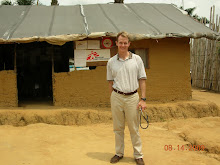
29 August 2009
Even in this country where children are malnourished, people have pets. I don't see them so much in town, but each time we drive to Mungele, we pass three or four dogs. They look about the same-sandy brown mutts, long pointy ears, and skinny. No matter what they look like, you know their family loves them and gets lots in return. It's nice to see this bit of "love luxury".
We have a pet at Kalibatete. It's a duckling. When I first arrived it was very tiny but is now adolescent duck sized. All day it walks around the clinic, circling the waiting area, the pharmacy, and the four exam rooms. If you leave a door open he'll walk in, take a look around, peck the hard dirt floor a couple of times, and waddle out. After it rains he's in heaven. There are puddles everywhere to explores and splash around. Though bold he stays slightly more than one arm's length away. I've tried to coax him into eating from my hand, but still no luck.
Greetings are interesting here. Since most people speak Swahili as a primary language, they say "jambo" to each other at any time of the day. As a white person, I am always greeted in French. As expected, in the morning that involves "Bonjour." People generally work from 8 a.m. until 1 p.m. and then take a break, called "le repos." (pronounced rah-poe, accent on the second syllable). Here le repos is only one hour but it's a very special hour. Until 2 p.m., people greet each other with "bon après-midi". Although to my knowledge this salutation exists in neither France nor Belgium, it is ingrained in French-speaking Africa. When le repos is over at 2 p.m., everyone switches to "bonsoir" (good evening). This is a bit hard to believe as the sun his still very hot and high in the sky. Yet at 2:01 p.m., I walk down the street, sweat profusely, get sunburnt, and tell everyone "bonsoir."
Truthfully, it's not quite as strict as that. I have heard a few radicals saying "Bonjour" even later than 2 p.m.
You know how you go to a nice restaurant and on the menu they usually have some permutation of a free range chicken breast wrapped around something fattening and delicious? You order it and the meat is thick and juicy and flavourful?
Real live Congolese free range chickens are none of these things. The breast meat on a chicken here is ¼ inch thick, challenging to get off the bone, and sometimes difficult to chew. The remainder of the chicken is even leaner. Chicken legs served at Couvent are the size of quail legs served in the US. The wings are laughable.
So what is free range chicken in the US? I'm thinking that probably even organic free range chickens in the US are restricted in activity and have been bred for generations to have really thick breast meat. I know they aren't allowed to be pumped full of hormones, but they are not chicken in its natural state.

No comments:
Post a Comment